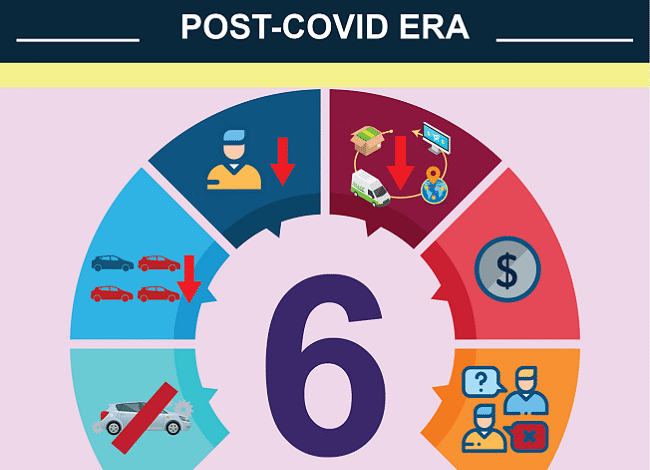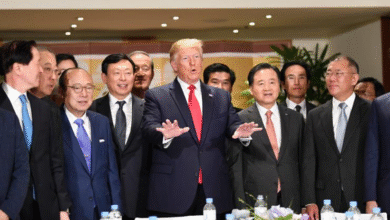Automotive Industry Challenges: Navigating the Polycrisis

The automotive industry faces formidable challenges that threaten its very foundation, encompassing a spectrum of crises collectively referred to as a “polycrisis in automotive.” As manufacturers grapple with escalating production costs, U.S. tariffs, and an unpredictable global auto market, their struggle is further compounded by stringent EU emissions regulations. This volatile environment has led to increased competition and supply chain disruptions, leaving car manufacturers teetering on the edge of a crisis. With the industry pivoting toward an electric vehicle transition, the stakes have never been higher. Industry leaders acknowledge this perfect storm of challenges, urging for a collaborative approach to stabilize and innovate for future sustainability.
The current state of the car manufacturing landscape can be described as a confluence of overlapping challenges that impact automakers globally. As businesses navigate a climate of heightened financial strain, they find themselves contending not only with regulatory demands but also with an urgent need to adopt cleaner technologies amid shifting consumer preferences. From tightening economic policies to the rise of electric mobility, the transformative pressures reshaping the automotive sector require an urgent reassessment of strategies. Automotive giants must adapt swiftly to ensure resilience, while simultaneously addressing the dual demands of profitability and environmental responsibility. In this tumultuous era of change, the quest for sustainable solutions becomes paramount.
Understanding the Polycrisis in the Automotive Industry
The term ‘polycrisis’ has emerged as a defining concept for the challenges faced by the automotive sector today. It encapsulates the simultaneous issues of rising production costs, regulatory pressures, and evolving market dynamics. Car manufacturers are experiencing intense competition while also transitioning toward electric vehicles (EVs) amid stringent EU emissions regulations. This scenario does not merely imply a collection of isolated problems; rather, it suggests a complex interplay of pressures that, when combined, create a crisis that feels far more severe than any single issue. As the automotive industry wrestles with these intertwined challenges, stakeholders must recognize the urgency of collaborative solutions for navigating this multifaceted crisis.
This complex environment necessitates an adaptive approach from automotive companies. Strategically addressing the polycrisis involves re-evaluating investment plans and operational strategies, particularly with respect to electric vehicle development and alternative mobility solutions. OEMs must harness innovation and leverage partnerships to mitigate the impact of regulatory pressures and fulfill consumer demand in a rapidly changing marketplace.
Furthermore, the implications of the polycrisis reach far beyond immediate financial concerns. The shift towards electric vehicles is not merely a trend but a critical necessity driven by evolving customer preferences and regulations aimed at achieving carbon neutrality. Top executives have signaled that the transition to zero-emission vehicles will dictate the industry’s trajectory. Yet, the integration of new technology into established manufacturing processes poses significant challenges that require substantial capital and resources. Addressing these issues calls for a commitment to resilience and an openness to embrace change in operational methodologies to align with new market realities.
Emerging Challenges in the Global Auto Market
The global auto market is currently undergoing unprecedented change, driven by technological advancements, regulatory shifts, and geopolitical factors. Manufacturers are facing heightened scrutiny from both consumers and governments regarding environmental impact, making compliance with EU emissions regulations imperative. The rapid shift towards electric vehicles has become a focal point for major car manufacturers, who must alleviate concerns over emissions while potentially sacrificing short-term profits. This complex balancing act poses substantial challenges for carmakers, highlighting the need for innovative solutions to thrive in an evolving landscape that is increasingly shaped by sustainability demands.
In addition to regulatory pressures, the global auto market is witnessing significant shifts in consumer preferences. As customers prioritize sustainability and advanced technology, traditional car manufacturers must adapt their product lines to meet these expectations. The emergence of new competitors, particularly from China, has intensified competition and added further pressure on Western OEMs to innovate rapidly. The stakes are high: failure to meet these evolving demands could result in diminished market share and long-term repercussions on competitiveness. Consequently, the global auto industry stands at a crossroad, where strategic foresight will be pivotal to navigate ongoing challenges.
The Electric Vehicle Transition: Opportunities and Dilemmas
As the automotive industry stakes its future on the electric vehicle transition, opportunities abound alongside significant dilemmas. The move towards electromobility promises a path to reduced emissions and compliance with increasingly rigorous EU regulations. Car manufacturers are investing billions into innovations such as battery technology and charging infrastructure, seeing these investments as critical to capturing a significant share of the burgeoning EV market. However, the imperative to transition is fraught with challenges; many OEMs face production capacity constraints and supply chain disruption, particularly in sourcing materials vital for battery production.
In parallel, the need for skilled labor has surged as the industry pivots towards more technologically sophisticated vehicles. Upskilling the workforce to handle advanced manufacturing processes and vehicle electrification represents both an opportunity and a challenge. There’s the risk of job dislocation within traditional sectors of the industry, particularly for workers involved in internal combustion engine production. Balancing these workforce transitions while pursuing cutting-edge developments in EV technology will be crucial for ensuring a sustainable and inclusive automotive future.
Navigating EU Emission Regulations Effectively
Navigating the highly stringent EU emission regulations has become one of the foremost challenges facing the automotive industry. With the European Commission’s commitment to a 55% reduction in carbon emissions from new vehicles by 2030, car manufacturers must align their strategies with these ambitious goals while simultaneously addressing the pressures of a challenging economic landscape. This necessitates not only developing cleaner technologies but also understanding the complex regulatory framework that governs emissions and ensures compliance. For many, finding the proper balance between innovation and cost-effective production processes has proven to be a formidable task.
The role of regulatory frameworks extends beyond compliance; they can also serve as catalysts for innovation. The pressure to adhere to EU standards has prompted companies to accelerate their transition towards greener technologies and practices. This investment in sustainability can lead to new business opportunities as consumers increasingly favor environmentally conscious products. However, the challenges posed by regulatory changes require automotive stakeholders to remain vigilant, adaptable, and proactive in their response to an ever-evolving regulatory environment.
Impact of the Car Manufacturers Crisis
The current crisis experienced by car manufacturers can be attributed to multifaceted pressures that interlink production costs, shifting consumer demands, and stringent regulatory environments. As companies contend with declining profits and rising expenses, layoffs and widespread cost-cutting measures have become frequent responses. The ongoing disruptions in supply chains, exacerbated by global geopolitical tensions and trade restrictions, further intensify the situation, highlighting the fragility of the industry’s operational frameworks. Understanding the roots of this crisis is essential for industry players aiming to realign their strategies for sustainability and competitiveness.
Moreover, the crisis serves as a stark reminder of the challenges associated with historical reliance on the internal combustion engine. With a significant push toward electrification and sustainability, traditional business models are becoming increasingly obsolete. The car manufacturers that adapt to this paradigm shift will likely emerge stronger, while those resistant to change may find themselves on the brink of obsolescence. Thus, embracing innovation and rethinking corporate strategies in light of these challenges will be paramount for the future of the automotive industry.
Strategic Partnerships and Collaboration
In response to the intense challenges, car manufacturers are increasingly recognizing the value of strategic partnerships and collaboration as a means to thrive in a rapidly evolving automotive landscape. Forming alliances—whether with technology firms for advancements in automotive tech or with battery manufacturers—can significantly accelerate the pace of innovation while distributing costs and sharing risks. Such partnerships not only enhance access to vital resources and expertise but also help in adapting rapidly to regulatory changes and shifting market demands. This collaborative approach can be key to navigating the intricacies of the polycrisis the industry currently faces.
Furthermore, partnerships with governmental entities could aid in shaping more favorable regulatory conditions that support sustainable practices within the automotive sector. By engaging in dialogue with regulatory bodies, manufacturers can advocate for policies that facilitate their transition to electric vehicles while ensuring compliance with emissions regulations. Successful collaboration across the automotive value chain will not only foster resilience in the face of ongoing challenges but also create a robust framework for sustainable growth moving forward.
The Role of Innovation in Addressing Automotive Challenges
In the face of the myriad challenges confronting the automotive industry, innovation stands out as a beacon of hope and opportunity. Embracing cutting-edge technologies—including artificial intelligence, advanced materials, and green energy solutions—can significantly enhance manufacturing efficiency and product offerings. By pivoting towards innovative processes, car manufacturers can reduce costs and improve the performance and sustainability of their vehicles. This proactive approach is essential for aligning with evolving consumer expectations and regulatory frameworks amidst the turbulent landscape of the auto market.
Moreover, investing in the research and development of innovative solutions allows car manufacturers to not only meet compliance standards but also to anticipate future regulatory shifts. In a world where electric vehicles are no longer just an alternative but increasingly becoming the norm, innovation could serve as the differentiator between market leaders and those left behind. By fostering a culture of continuous improvement and embracing new technologies, the automotive industry can effectively tackle its current challenges while simultaneously paving the way for a sustainable future.
Future Outlook for the Automotive Industry
Looking forward, the automotive industry faces both challenges and opportunities as it transitions into a more sustainable and technologically advanced sector. The global push towards electric vehicles and adherence to stringent emissions regulations represents a considerable hurdle, yet it also catalyzes innovation and transformation within the industry. As manufacturers re-evaluate their strategies and embrace a future of decarbonization, those who prioritize sustainable practices are poised to thrive in the evolving marketplace. This demand for environmentally responsible production methods and products will likely reshape the contours of competition in the automotive sector.
Additionally, the ongoing pressures from global economic dynamics and trade policies will require manufacturers to remain agile and responsive to external challenges. Resilience will be key in navigating the transition toward a sustainable automotive landscape. Companies that successfully leverage innovation, strategic partnerships, and consumer insights will not only weather the challenges posed by the polycrisis but will emerge as leaders in the global auto market. The future will undoubtedly require a profound transformation, but with it comes the potential for a more sustainable, innovative, and competitive automotive industry.
Frequently Asked Questions
What are the main automotive industry challenges facing manufacturers today, including the polycrisis?
The automotive industry is currently facing a polycrisis marked by rising production costs, regulatory pressures, intense global competition, and supply chain disruptions. Major challenges include adapting to EU emissions regulations, transitioning to electric vehicles, and dealing with geopolitical tensions that affect market stability.
How are electric vehicle transitions impacting the automotive industry amidst current challenges?
The transition to electric vehicles (EVs) is central to the automotive industry’s challenges. While it presents opportunities for innovation, it also requires significant investment in new manufacturing processes and technology, amid stringent EU emissions regulations and reduced consumer incentives, complicating overall market growth.
What role do EU emissions regulations play in the current automotive industry crisis?
EU emissions regulations are among the most ambitious globally and pose significant challenges for car manufacturers. With mandates for substantial reductions in carbon emissions and a full transition to zero-emission vehicles by 2035, these regulations strain manufacturers financially, especially during a polycrisis that affects production and demand.
How is the global auto market responding to the crises and challenges in the automotive industry?
The global auto market is experiencing fragmentation as manufacturers adapt to local conditions due to rising protectionism and competition. Western companies are re-evaluating their strategies, focusing on hybrid models, and pursuing partnerships, particularly with Chinese firms, to navigate the challenges posed by the polycrisis in the automotive sector.
What strategies are car manufacturers implementing to overcome current automotive industry challenges?
To manage the challenges of the polycrisis, automotive manufacturers are prioritizing value-over-volume strategies, investing heavily in innovation, and exploring new markets. This includes relocating production, diversifying vehicle offerings such as hybrids, and enhancing collaboration with global partners, especially from China.
Can automotive manufacturers maintain profitability during this polycrisis?
Maintaining profitability during the polycrisis is exceptionally challenging for car manufacturers due to rising costs and regulatory pressures. However, by focusing on high-margin vehicles, strategic partnerships, and embracing electrification, manufacturers may find pathways to sustain financial performance amidst these obstacles.
How does the polycrisis affect the future of car manufacturers in the automotive industry?
The polycrisis presents both risks and opportunities for car manufacturers. It compels them to innovate rapidly, adapt business models, and invest in sustainable technologies. While challenges like declining profits and heightened competition loom large, a proactive approach may lead to a stronger, more resilient automotive industry in the long run.
| Key Point | Details |
|---|---|
| Multiple Crises Facing OEMs | Top original equipment manufacturers are grappling with several simultaneous crises affecting their performance. |
| Rising Costs and Tariffs | U.S. tariffs, increasing production costs, and intense competition are impacting the automotive industry. |
| Supply Chain Disruptions | Many manufacturers are facing significant hurdles due to supply chain interruptions. |
| Regulatory Pressures | Regulatory demands for emissions reductions add to the challenges car manufacturers face. |
| Industry Transformations | The shift toward zero-emission vehicles presents a major challenge for OEMs. |
| Response Strategies | Carmakers are focusing on higher-margin models, hybrid offerings, and production in low-cost nations. |
Summary
The automotive industry challenges are becoming increasingly complex as OEMs navigate a landscape marked by crises such as rising costs, intense competition, and regulatory pressures. With the transition to electric vehicles underway, manufacturers are feeling the strain of competing in a market that is both volatile and demanding. The convergence of these factors — termed a ‘polycrisis’ — has led to a strategic recalibration within the industry as companies seek innovation and collaboration to sustain their operations and thrive in the future.




